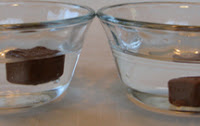
What you need:
- small plastic bottle of water
- wrapped Warheads candies(don't unwrap!)
What to do:
- Open a bottle of water and push the wrapped Warhead inside.
- Make sure the Warhead floats. If you put it in the bottle and it sinks immediately, try another one. (Some Warhead packages don't contain enough air to float.)
- Fill the bottle completely full, so that there are no air bubbles at the top. Any extra air bubbles will make the Warhead harder to sink.
- Screw the bottle cap on tightly, or you'll send water shooting everywhere.
- Squeeze the bottle and see if you can make the Warhead sink!
What's happening:
Warheads sink. Air bubbles float. A Warhead inside an airtight wrapper does both...if you squeeze it hard enough to compress the air bubble. This makes the candy wrapper package denser than the water, and it sinks. But if you release the bottle, the bubble expands and the candy floats again!
This science demonstration is called a Cartesian diver, named after French philosopher and scientist René Descartes. You can also try making a Cartesian diver with ketchup packets, eyedroppers, or other items that trap air bubbles.
As featured in Scout Life magazine
From the book Candy Experiments 2 by Loralee Leavitt











